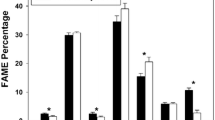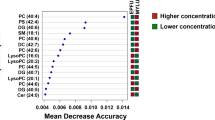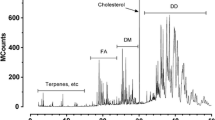Abstract
The composition of wax esters (WE) in the fur of adult greater mouse–eared bats (Myotis myotis), either healthy or suffering from white nose syndrome (WNS) caused by the psychrophilic fungus Pseudogymnoascus destructans, was investigated by high-resolution mass spectrometry analysis in the positive ion mode. Profiling of lipid classes showed that WE are the most abundant lipid class, followed by cholesterol esters, and other lipid classes, e.g., triacylglycerols and phospholipids. WE abundance in non-polar lipids was gender-related, being higher in males than in females; in individuals suffering from WNS, both male and female, it was higher than in healthy counterparts. WE were dominated by species containing 18:1 fatty acids. Fatty alcohols were fully saturated, dominated by species containing 24, 25, or 26 carbon atoms. Two WE species, 18:1/18:0 and 18:1/20:0, were more abundant in healthy bats than in infected ones.









Similar content being viewed by others
Abbreviations
- APCI:
-
Atmospheric pressure chemical ionization
- APCI-MS/MS:
-
Atmospheric pressure chemical ionization-tandem MS
- APPI:
-
Atmospheric pressure photoionization
- CE:
-
Cholesterol esters
- CID:
-
Collision-induced dissociation
- DB:
-
Double bond
- ESI:
-
Electrospray ionization
- FA:
-
Fatty acids
- FAl:
-
Fatty alcohols
- FT:
-
Fourier transformation
- H-ESI:
-
Heated ESI
- HPLC/APCI/MS:
-
High-performance liquid chromatography with atmospheric pressure chemical ionization mass spectrometry
- FIA:
-
Flow injection analysis
- MALDI:
-
Matrix-assisted laser desorption ionization
- MRM:
-
Multiple reaction monitoring
- PCR:
-
Polymerase chain reaction
- PCA:
-
Principal component analysis
- MS2 :
-
Tandem MS
- ANOVA:
-
Two-way analysis of variance
- WE:
-
Wax esters
- WNS:
-
White-nose syndrome
References
Blehert DS, Hicks AC, Behr M, Meteyer CU, Berlowski-Zier BM, Buckles EL, Coleman JTH, Darling SR, Gargas A, Niver R, Okoniewski JC, Rudd RJ, Stone WB (2009) Bat white nose syndrome: an emerging fungal pathogen? Science 323:227
Gargas A, Trest MT, Christensen M, Volk TJ, Blehert DS (2009) Geomyces destructans sp. nov. associated with bat white nose syndrome. Mycotaxon 108:147–154
Wibbelt G, Kurth A, Hellmann D, Weishaar M, Barlow A, Veith M, Prüger J, Görföl T, Grosche L, Bontadina F, Zöphe U, Seidl HP, Cryan PM, Blehert DS (2010) White-nose syndrome fungus (Geomyces destructans) in bats Europe. Emerg Infect Dis 16:1237–1242
Puechmaille SJ, Frick WF, Kunz TH, Racey PA, Voigt CC, Wibbelt G, Teeling EC (2011) White-nose syndrome: is this emerging disease a threat to European bats? Trends Ecol Evol 26:570–576
Pikula J, Bandouchova H, Novotny L, Meteyer CU, Zukal J, Irwin NR, Zima J, Martinkova N (2012) Histopathology confirms white-nose syndrome in bats in Europe. J Wildl Dis 48:207–211
Martinkova N, Backor P, Bartonicka T, Blazkova P, Cerveny J et al (2010) Increasing incidence of Geomyces destructans fungus in bats from the Czech Republic and Slovakia. PLoS One 5(11):e13853
Bandouchova H, Bartonicka T, Berkova H, Brichta J, Cerny J, Kovacova V, Kolarik M, Kollner B, Kulich P, Martinkova N, Rehak Z, Turner GG, Zukal J, Pikula J (2015) Pseudogymnoascus destructans: evidence of virulent skin invasion for bats under natural conditions, Europe. Transbound Emerg Dis 62:1–5
Meteyer CU, Buckles EL, Blehert DS, Hicks AC, Green DE, Shearn-Bochsler V, Thomas NJ, Gargas A, Behr MJ (2009) Histopathologic criteria to confirm white nose syndrome in bats. J Vet Diagn Invest 21:411–414
Zukal J, Bandouchova H, Bartonicka T, Berkova H, Brack V, Brichta J, Dolinay M, Jaron KS, Kovacova V, Kovarik K, Martinkova N, Ondracek K, Rehak Z, Turner GG, Pikula J (2014) White-nose syndrome fungus: a generalist pathogen of hibernating bats. PLoS One 9(5):e97224
Munoz-Garcia A, Ro J, Reichard JD, Kunz TH, Williams JB (2012) Cutaneous water loss and lipids of the stratum corneum in two syntopic species of bats. Comp Biochem Physiol A 161:208–215
Nicolaides N, Hwei HC, Rice GR (1968) The skin surface lipids of man compared with those of eighteen species of animals. J Investig Dermatol 51:83–89
Smith KR, Thiboutot DM (2008) Sebaceous gland lipids: friend or foe? J Lipid Res 49:271–281
Rawlings AV (1995) Skin waxes: their composition, properties, structures and biological significance. In: Hamilton RJ (ed) Waxes: chemistry, molecular biology and functions. The Oily Press, Dundee, pp 223–256
Rezanka T, Podojil M (1986) Identification of wax esters of the fresh-water green alga Chlorella kessleri by gas chromatography-mass spectrometry. J Chromatogr 362:399–406
Rezanka T, Sigler K (2006) Identification of very long chain fatty acids from sugar cane wax by atmospheric pressure chemical ionization liquid chromatography-mass spectroscopy. Phytochemistry 67:916–923
Fitzgerald M, Murphy RC (2007) Electrospray mass spectrometry of human hair wax esters. J Lipid Res 48:1231–1246
Turner GG, Meteyer CU, Barton H, Gumbs JF, Reeder DM, Overton B, Bandouchova H, Bartonicka T, Martinkova N, Pikula J, Zukal J, Blehert DS (2014) Non-lethal screening of bat wing skin using UV fluorescence to detect lesions indicative of white-nose syndrome. J Wildl Dis 50:566–573
Muller LK, Lorch JM, Lindner DL, O’Connor M, Gargas A, Blehert DS (2013) Bat white nose syndrome: a real-time TaqMan polymerase chain reaction test targeting the intergenic spacer region of Geomyces destructans. Mycologia 105:253–259
Motiuk K (1978) Wool wax acids: a review. J Am Oil Chem Soc 56:91–97
Motiuk K (1978) Wool wax-alcohols: a review. J Am Oil Chem Soc 56:651–658
Chen J, Green KB, Nichols KK (2013) Quantitative profiling of major neutral lipid classes in human meibum by direct infusion electrospray ionization mass spectrometry. Invest Ophthal Vis Sci 54:5730–5753
Harvey DJ, Tiffany JM, Duerden JM, Pandher KS, Mengher LS (1987) Identification by combined gas chromatography-mass spectrometry of constituent long-chain fatty acids and alcohols from the meibomian glands of the rat and a comparison with human meibomian lipids. J Chromatogr 414:253–263
Pannkuk EL, Gilmore DF, Savary BJ, Risch TS (2012) Triacylglyceride (TAG) profiles of integumentary lipids isolated from three bat species determined by matrix-assisted laser desorption–ionization time-of-flight mass spectrometry (MALDI–TOF MS). Can J Zool 90:1117–1127
Pannkuk EL, Mcguire LP, Gilmore DF, Savary BJ, Risch TS (2014) Glycerophospholipid analysis of eastern red bat (Lasiurus borealis) hair by electrospray ionization tandem mass spectrometry. J Chem Ecol 40:227–235
Pannkuk EL, Fuller NW, Moore PR, Gilmore DR, Savary BJ, Risch TS (2014) Fatty acid methyl ester profiles of bat wing surface lipids. Lipids 49:1143–1150
Pannkuk EL, Gilmore D, Fuller N, Savary BJ, Risch TS (2013) Sebaceous lipid profiling of bat integumentary tissues: quantitative analysis of free fatty acids, monoacylglycerides, squalene, and sterols. Chem Biodivers 10:2122–2132
Naegele E (2011) Making your LC method compatible with mass spectrometry. Technical overview. Agilent Technologies, Inc. http://www.chem.agilent.com/Library/technicaloverviews/Public/5990--7413EN.pdf. Accessed 11 May 2015
Hamilton RJ (ed) (1995) Waxes: chemistry, molecular biology and functions. Oily Press, Dundee
Seyama Y, Otsuka H, Ohashi K, Vivienroels B, Pevet P (1995) Sexual dimorphism of lipids in Harderian glands of golden hamsters. J Biochem 117:661–670
Mikova R, Vrkoslav V, Hanus R, Hakova E, Habova Z, Dolezal A, Plavka R, Coufal P, Cvacka J (2014) Newborn boys and girls differ in the lipid composition of vernix caseosa. PLoS One 9(6):e99173
Acknowledgments
The research was supported by the Czech Science Foundation (Project P506/12/1064) and by the Institutional Research Concept RVO61388971.
Author information
Authors and Affiliations
Corresponding author
Electronic supplementary material
Below is the link to the electronic supplementary material.
About this article
Cite this article
Řezanka, T., Viden, I., Nováková, A. et al. Wax Ester Analysis of Bats Suffering from White Nose Syndrome in Europe. Lipids 50, 633–645 (2015). https://doi.org/10.1007/s11745-015-4027-7
Received:
Accepted:
Published:
Issue Date:
DOI: https://doi.org/10.1007/s11745-015-4027-7




